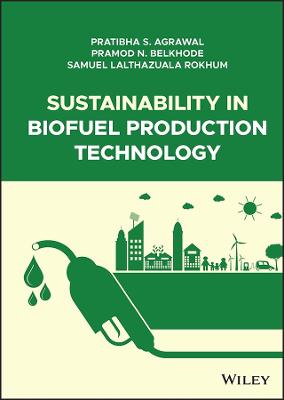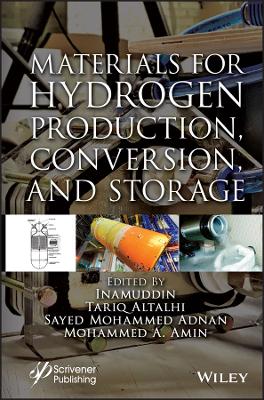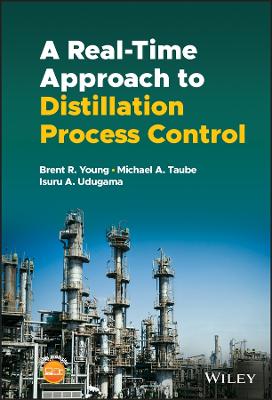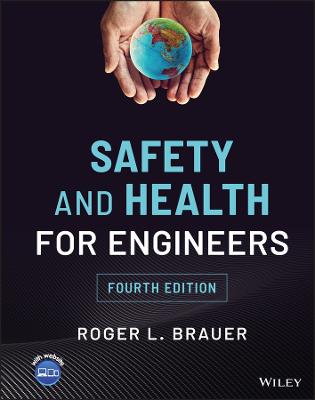Sustainability in Biofuel Production Technology
 -15%
portes grátis
-15%
portes grátis
Sustainability in Biofuel Production Technology
Rokhum, Samuel Lalthazuala; Agrawal, Pratibha S.; Belkhode, Pramod N.
John Wiley & Sons Inc
10/2022
368
Dura
Inglês
9781119888833
15 a 20 dias
826
Descrição não disponível.
Preface xi
1 Introduction to Biofuel 1
1.1 Introduction 1
1.2 History of Biofuel Development 3
1.3 Generation in Biofuel 4
1.4 Classification of Biofuels 8
1.5 Technologies Involved in Biofuel Production 10
1.6 Biofuel Properties 11
1.7 Socioeconomic and Environmental Impact 12
1.8 Conclusion 17
2 Ethanol as the Leading 'First-Generation' Biofuel 27
2.1 Introduction 27
2.2 Historical Development of Ethanol as Biofuels 30
2.3 Environmental Aspects of Using Ethanol as Biofuels 38
2.4 Cost Models of Ethanol as Biofuels 42
2.5 Sustainability Aspects -- Need of Alternative Biofuel 43
2.6 Summary 46
3 Advanced Biofuels -- Alternatives to Biofuels 53
3.1 Introduction 53
3.2 Biofuels Deserve Another Look 55
3.3 Global Production, Need and Demand 58
3.4 Feedstock for Advanced Biofuels 61
3.5 Advanced Biofuels for Different Applications 62
3.6 Commercial Development 63
3.7 Aviation Fuel and Green Diesel 65
3.8 Conclusion 65
4 Biofuel Production Technologies -- An Overview 75
4.1 Introduction 75
4.2 Industry Challenges Associated with Biofuels 76
4.3 Edible Vegetable to Non-edible/Low-cost Raw Materials for Biodiesel Production 76
4.4 Development of Chemical Conversion Technologies 80
4.5 Development of Thermochemical Conversion Technologies 81
4.6 Development of Biological Conversion Technologies 83
4.7 Development of Biochemical Conversion Technologies 83
4.8 Technology Innovation in Biofuel Production 85
4.9 Process Integration and Biorefinery 87
4.10 Alternatives to Biofuel Production 88
4.11 Technology Survey 88
4.12 Key Collaborations for Biofuel Production 90
4.13 Market Research on Biofuels 90
4.14 Future Trends 91
4.15 Summary 92
5 Chemically Produced Biofuels 99
5.1 Introduction 99
5.2 Triglycerides -- Best Participant as Fuels 99
5.3 Biogas Using Anaerobic Digestion 107
5.4 Catalytic Biofuel Production 110
5.5 Nanoparticles Potential in Biofuel Production 112
5.6 Production Cost Analysis 115
5.7 Environmental Footprints of Chemical Processes 117
5.8 Future Demand and Scope 120
5.9 Conclusion 120
6 Microalgae -- Biofuel Production Trends 129
6.1 Introduction 129
6.2 Technology for Microalgae Cultivation 131
6.3 Biofuels from Microalgae 136
6.4 Role of Nanoadditives in Algae-based Biofuel Production 142
6.5 Cost Analysis of Microalgae-based Biofuel Production 144
6.6 Challenges and Opportunities in Microalgae-based Biofuel Production 145
6.7 Summary 146
7 Agro-Waste-Produced Biofuels 153
7.1 Introduction 153
7.2 Agricultural Waste and Residues as Valuable Materials 153
7.3 Pre-treatment of Agro-waste 154
7.4 Process Technology -- Agro-waste to Bioenergy 157
7.5 Creating Wealth from The Agricultural Waste 158
7.6 Economic Valuation of Agro-waste 160
7.7 Impact of Agricultural Waste 162
7.8 Current Challenges and Future Trends 162
7.9 Summary 163
8 Biofuels for Aviation 169
8.1 Introduction 169
8.2 Chemistry of Fuel Molecules 171
8.3 Alcohol to Jet (ATJ) 174
8.4 Oil to Jet (OTJ) 178
8.5 Gas to Jet (GTJ) 182
8.6 Sugar-to-Jet (STJ) Fuel 184
8.7 Overview of Blending Sustainable Aviation Fuel 186
8.8 Summary 186
9 State of the Art Design and Fabrication of a Reactor in Biofuel Production 195
9.1 Introduction 195
9.2 Limitation of Conventional Production Technology 196
9.3 Ideal Reactors 197
9.4 Reaction Designing from an Engineering Aspect 198
9.5 Process Parameters in Reactor Designing 198
9.6 Safety Consideration of Reaction Design 200
9.7 Reactors for Biodiesel Production 201
9.8 Ultrasonic Biodiesel Reactors 202
9.9 Supercritical Reactors 202
9.10 Static Mixers as Biodiesel Reactors 203
9.11 Reactive Distillation 203
9.12 Capital Cost and Performance Analysis of Reactors 203
9.13 Summary 203
10 Modelling and Simulation to Predict the Performance of the Diesel Blends 209
10.1 Introduction 209
10.2 Cause and Effect Relationships 210
10.3 Approach to Formulate 210
10.4 Concept of Man--Machine System 210
10.5 Formulation of the Mathematical Model 215
10.6 Limitations of Adopting the Experimental Database Model 217
10.7 Identification of Causes and Effects of an Activity 217
10.8 Dimensional Analysis 218
10.9 Case Study on the Engine Performance by Using Alternative Fuels 221
10.10 Establishment of Dimensionless Group of ? Terms 225
10.11 Summary 261
11 Challenges to Biofuel Development 267
11.1 Introduction 267
11.2 Key Issues and Challenges in Biofuel Production Pathways 268
11.3 Other Glycerol Derivatives in Diesel Production 270
11.4 Biofuel Blends and Future Trends 272
11.5 Environmental Effects of Biofuels 273
11.6 Economic Impact of Biofuels 278
11.7 Biorefineries 286
11.8 Summary 288
12 Greener Catalytic Processes in Biofuel Production 295
12.1 Introduction 295
12.2 Sustainable Catalysts 296
12.3 Summary 307
13 Life Cycle Assessment 315
13.1 Introduction 315
13.2 Life Cycle Assessment of Biomass 316
13.3 Feedstock Used 316
13.4 Purpose of Life Cycle Impact Assessment 317
13.5 Life Cycle for Fossil Fuels 318
13.6 Ethanol Life Cycle 319
13.7 Life Cycle Analysis 320
13.8 ISO Life Cycle Assessment Standards 321
13.9 Life Cycle Assessment Benefits 322
13.10 Role of LCA in Public Policies/Regulations 322
13.11 Conclusion 323
14 Socioeconomic Impact of Biofuel 329
14.1 Introduction 329
14.2 Employment Opportunities in Biofuel Production Industries 331
14.3 Socioeconomic and Environmental Impact 332
14.4 Biodiesel Industries 333
14.5 Export and Import of Biodiesel 334
14.6 Production of Biodiesel 335
14.7 Economic Impact of Biofuels 336
14.8 The Development of Renewable Energy Based on Income 338
14.9 The Development of Renewable Energy Based on Carbon Emission 339
14.10 Biofuel Impact on the Society 339
14.11 Barriers in the Production of Biofuels 340
14.12 Biofuel Desire to Improve the Balance of Trade 340
14.13 Conclusion 341
References 342
Index 347
1 Introduction to Biofuel 1
1.1 Introduction 1
1.2 History of Biofuel Development 3
1.3 Generation in Biofuel 4
1.4 Classification of Biofuels 8
1.5 Technologies Involved in Biofuel Production 10
1.6 Biofuel Properties 11
1.7 Socioeconomic and Environmental Impact 12
1.8 Conclusion 17
2 Ethanol as the Leading 'First-Generation' Biofuel 27
2.1 Introduction 27
2.2 Historical Development of Ethanol as Biofuels 30
2.3 Environmental Aspects of Using Ethanol as Biofuels 38
2.4 Cost Models of Ethanol as Biofuels 42
2.5 Sustainability Aspects -- Need of Alternative Biofuel 43
2.6 Summary 46
3 Advanced Biofuels -- Alternatives to Biofuels 53
3.1 Introduction 53
3.2 Biofuels Deserve Another Look 55
3.3 Global Production, Need and Demand 58
3.4 Feedstock for Advanced Biofuels 61
3.5 Advanced Biofuels for Different Applications 62
3.6 Commercial Development 63
3.7 Aviation Fuel and Green Diesel 65
3.8 Conclusion 65
4 Biofuel Production Technologies -- An Overview 75
4.1 Introduction 75
4.2 Industry Challenges Associated with Biofuels 76
4.3 Edible Vegetable to Non-edible/Low-cost Raw Materials for Biodiesel Production 76
4.4 Development of Chemical Conversion Technologies 80
4.5 Development of Thermochemical Conversion Technologies 81
4.6 Development of Biological Conversion Technologies 83
4.7 Development of Biochemical Conversion Technologies 83
4.8 Technology Innovation in Biofuel Production 85
4.9 Process Integration and Biorefinery 87
4.10 Alternatives to Biofuel Production 88
4.11 Technology Survey 88
4.12 Key Collaborations for Biofuel Production 90
4.13 Market Research on Biofuels 90
4.14 Future Trends 91
4.15 Summary 92
5 Chemically Produced Biofuels 99
5.1 Introduction 99
5.2 Triglycerides -- Best Participant as Fuels 99
5.3 Biogas Using Anaerobic Digestion 107
5.4 Catalytic Biofuel Production 110
5.5 Nanoparticles Potential in Biofuel Production 112
5.6 Production Cost Analysis 115
5.7 Environmental Footprints of Chemical Processes 117
5.8 Future Demand and Scope 120
5.9 Conclusion 120
6 Microalgae -- Biofuel Production Trends 129
6.1 Introduction 129
6.2 Technology for Microalgae Cultivation 131
6.3 Biofuels from Microalgae 136
6.4 Role of Nanoadditives in Algae-based Biofuel Production 142
6.5 Cost Analysis of Microalgae-based Biofuel Production 144
6.6 Challenges and Opportunities in Microalgae-based Biofuel Production 145
6.7 Summary 146
7 Agro-Waste-Produced Biofuels 153
7.1 Introduction 153
7.2 Agricultural Waste and Residues as Valuable Materials 153
7.3 Pre-treatment of Agro-waste 154
7.4 Process Technology -- Agro-waste to Bioenergy 157
7.5 Creating Wealth from The Agricultural Waste 158
7.6 Economic Valuation of Agro-waste 160
7.7 Impact of Agricultural Waste 162
7.8 Current Challenges and Future Trends 162
7.9 Summary 163
8 Biofuels for Aviation 169
8.1 Introduction 169
8.2 Chemistry of Fuel Molecules 171
8.3 Alcohol to Jet (ATJ) 174
8.4 Oil to Jet (OTJ) 178
8.5 Gas to Jet (GTJ) 182
8.6 Sugar-to-Jet (STJ) Fuel 184
8.7 Overview of Blending Sustainable Aviation Fuel 186
8.8 Summary 186
9 State of the Art Design and Fabrication of a Reactor in Biofuel Production 195
9.1 Introduction 195
9.2 Limitation of Conventional Production Technology 196
9.3 Ideal Reactors 197
9.4 Reaction Designing from an Engineering Aspect 198
9.5 Process Parameters in Reactor Designing 198
9.6 Safety Consideration of Reaction Design 200
9.7 Reactors for Biodiesel Production 201
9.8 Ultrasonic Biodiesel Reactors 202
9.9 Supercritical Reactors 202
9.10 Static Mixers as Biodiesel Reactors 203
9.11 Reactive Distillation 203
9.12 Capital Cost and Performance Analysis of Reactors 203
9.13 Summary 203
10 Modelling and Simulation to Predict the Performance of the Diesel Blends 209
10.1 Introduction 209
10.2 Cause and Effect Relationships 210
10.3 Approach to Formulate 210
10.4 Concept of Man--Machine System 210
10.5 Formulation of the Mathematical Model 215
10.6 Limitations of Adopting the Experimental Database Model 217
10.7 Identification of Causes and Effects of an Activity 217
10.8 Dimensional Analysis 218
10.9 Case Study on the Engine Performance by Using Alternative Fuels 221
10.10 Establishment of Dimensionless Group of ? Terms 225
10.11 Summary 261
11 Challenges to Biofuel Development 267
11.1 Introduction 267
11.2 Key Issues and Challenges in Biofuel Production Pathways 268
11.3 Other Glycerol Derivatives in Diesel Production 270
11.4 Biofuel Blends and Future Trends 272
11.5 Environmental Effects of Biofuels 273
11.6 Economic Impact of Biofuels 278
11.7 Biorefineries 286
11.8 Summary 288
12 Greener Catalytic Processes in Biofuel Production 295
12.1 Introduction 295
12.2 Sustainable Catalysts 296
12.3 Summary 307
13 Life Cycle Assessment 315
13.1 Introduction 315
13.2 Life Cycle Assessment of Biomass 316
13.3 Feedstock Used 316
13.4 Purpose of Life Cycle Impact Assessment 317
13.5 Life Cycle for Fossil Fuels 318
13.6 Ethanol Life Cycle 319
13.7 Life Cycle Analysis 320
13.8 ISO Life Cycle Assessment Standards 321
13.9 Life Cycle Assessment Benefits 322
13.10 Role of LCA in Public Policies/Regulations 322
13.11 Conclusion 323
14 Socioeconomic Impact of Biofuel 329
14.1 Introduction 329
14.2 Employment Opportunities in Biofuel Production Industries 331
14.3 Socioeconomic and Environmental Impact 332
14.4 Biodiesel Industries 333
14.5 Export and Import of Biodiesel 334
14.6 Production of Biodiesel 335
14.7 Economic Impact of Biofuels 336
14.8 The Development of Renewable Energy Based on Income 338
14.9 The Development of Renewable Energy Based on Carbon Emission 339
14.10 Biofuel Impact on the Society 339
14.11 Barriers in the Production of Biofuels 340
14.12 Biofuel Desire to Improve the Balance of Trade 340
14.13 Conclusion 341
References 342
Index 347
Este título pertence ao(s) assunto(s) indicados(s). Para ver outros títulos clique no assunto desejado.
Biofuel technology; biofuel production technology; biofuel processes; biofuel process variables; biofuel mathematical modeling; biodiesel; aviation biofuels; biofuels production and development; biofuels performance analysis; alternative fuels
Preface xi
1 Introduction to Biofuel 1
1.1 Introduction 1
1.2 History of Biofuel Development 3
1.3 Generation in Biofuel 4
1.4 Classification of Biofuels 8
1.5 Technologies Involved in Biofuel Production 10
1.6 Biofuel Properties 11
1.7 Socioeconomic and Environmental Impact 12
1.8 Conclusion 17
2 Ethanol as the Leading 'First-Generation' Biofuel 27
2.1 Introduction 27
2.2 Historical Development of Ethanol as Biofuels 30
2.3 Environmental Aspects of Using Ethanol as Biofuels 38
2.4 Cost Models of Ethanol as Biofuels 42
2.5 Sustainability Aspects -- Need of Alternative Biofuel 43
2.6 Summary 46
3 Advanced Biofuels -- Alternatives to Biofuels 53
3.1 Introduction 53
3.2 Biofuels Deserve Another Look 55
3.3 Global Production, Need and Demand 58
3.4 Feedstock for Advanced Biofuels 61
3.5 Advanced Biofuels for Different Applications 62
3.6 Commercial Development 63
3.7 Aviation Fuel and Green Diesel 65
3.8 Conclusion 65
4 Biofuel Production Technologies -- An Overview 75
4.1 Introduction 75
4.2 Industry Challenges Associated with Biofuels 76
4.3 Edible Vegetable to Non-edible/Low-cost Raw Materials for Biodiesel Production 76
4.4 Development of Chemical Conversion Technologies 80
4.5 Development of Thermochemical Conversion Technologies 81
4.6 Development of Biological Conversion Technologies 83
4.7 Development of Biochemical Conversion Technologies 83
4.8 Technology Innovation in Biofuel Production 85
4.9 Process Integration and Biorefinery 87
4.10 Alternatives to Biofuel Production 88
4.11 Technology Survey 88
4.12 Key Collaborations for Biofuel Production 90
4.13 Market Research on Biofuels 90
4.14 Future Trends 91
4.15 Summary 92
5 Chemically Produced Biofuels 99
5.1 Introduction 99
5.2 Triglycerides -- Best Participant as Fuels 99
5.3 Biogas Using Anaerobic Digestion 107
5.4 Catalytic Biofuel Production 110
5.5 Nanoparticles Potential in Biofuel Production 112
5.6 Production Cost Analysis 115
5.7 Environmental Footprints of Chemical Processes 117
5.8 Future Demand and Scope 120
5.9 Conclusion 120
6 Microalgae -- Biofuel Production Trends 129
6.1 Introduction 129
6.2 Technology for Microalgae Cultivation 131
6.3 Biofuels from Microalgae 136
6.4 Role of Nanoadditives in Algae-based Biofuel Production 142
6.5 Cost Analysis of Microalgae-based Biofuel Production 144
6.6 Challenges and Opportunities in Microalgae-based Biofuel Production 145
6.7 Summary 146
7 Agro-Waste-Produced Biofuels 153
7.1 Introduction 153
7.2 Agricultural Waste and Residues as Valuable Materials 153
7.3 Pre-treatment of Agro-waste 154
7.4 Process Technology -- Agro-waste to Bioenergy 157
7.5 Creating Wealth from The Agricultural Waste 158
7.6 Economic Valuation of Agro-waste 160
7.7 Impact of Agricultural Waste 162
7.8 Current Challenges and Future Trends 162
7.9 Summary 163
8 Biofuels for Aviation 169
8.1 Introduction 169
8.2 Chemistry of Fuel Molecules 171
8.3 Alcohol to Jet (ATJ) 174
8.4 Oil to Jet (OTJ) 178
8.5 Gas to Jet (GTJ) 182
8.6 Sugar-to-Jet (STJ) Fuel 184
8.7 Overview of Blending Sustainable Aviation Fuel 186
8.8 Summary 186
9 State of the Art Design and Fabrication of a Reactor in Biofuel Production 195
9.1 Introduction 195
9.2 Limitation of Conventional Production Technology 196
9.3 Ideal Reactors 197
9.4 Reaction Designing from an Engineering Aspect 198
9.5 Process Parameters in Reactor Designing 198
9.6 Safety Consideration of Reaction Design 200
9.7 Reactors for Biodiesel Production 201
9.8 Ultrasonic Biodiesel Reactors 202
9.9 Supercritical Reactors 202
9.10 Static Mixers as Biodiesel Reactors 203
9.11 Reactive Distillation 203
9.12 Capital Cost and Performance Analysis of Reactors 203
9.13 Summary 203
10 Modelling and Simulation to Predict the Performance of the Diesel Blends 209
10.1 Introduction 209
10.2 Cause and Effect Relationships 210
10.3 Approach to Formulate 210
10.4 Concept of Man--Machine System 210
10.5 Formulation of the Mathematical Model 215
10.6 Limitations of Adopting the Experimental Database Model 217
10.7 Identification of Causes and Effects of an Activity 217
10.8 Dimensional Analysis 218
10.9 Case Study on the Engine Performance by Using Alternative Fuels 221
10.10 Establishment of Dimensionless Group of ? Terms 225
10.11 Summary 261
11 Challenges to Biofuel Development 267
11.1 Introduction 267
11.2 Key Issues and Challenges in Biofuel Production Pathways 268
11.3 Other Glycerol Derivatives in Diesel Production 270
11.4 Biofuel Blends and Future Trends 272
11.5 Environmental Effects of Biofuels 273
11.6 Economic Impact of Biofuels 278
11.7 Biorefineries 286
11.8 Summary 288
12 Greener Catalytic Processes in Biofuel Production 295
12.1 Introduction 295
12.2 Sustainable Catalysts 296
12.3 Summary 307
13 Life Cycle Assessment 315
13.1 Introduction 315
13.2 Life Cycle Assessment of Biomass 316
13.3 Feedstock Used 316
13.4 Purpose of Life Cycle Impact Assessment 317
13.5 Life Cycle for Fossil Fuels 318
13.6 Ethanol Life Cycle 319
13.7 Life Cycle Analysis 320
13.8 ISO Life Cycle Assessment Standards 321
13.9 Life Cycle Assessment Benefits 322
13.10 Role of LCA in Public Policies/Regulations 322
13.11 Conclusion 323
14 Socioeconomic Impact of Biofuel 329
14.1 Introduction 329
14.2 Employment Opportunities in Biofuel Production Industries 331
14.3 Socioeconomic and Environmental Impact 332
14.4 Biodiesel Industries 333
14.5 Export and Import of Biodiesel 334
14.6 Production of Biodiesel 335
14.7 Economic Impact of Biofuels 336
14.8 The Development of Renewable Energy Based on Income 338
14.9 The Development of Renewable Energy Based on Carbon Emission 339
14.10 Biofuel Impact on the Society 339
14.11 Barriers in the Production of Biofuels 340
14.12 Biofuel Desire to Improve the Balance of Trade 340
14.13 Conclusion 341
References 342
Index 347
1 Introduction to Biofuel 1
1.1 Introduction 1
1.2 History of Biofuel Development 3
1.3 Generation in Biofuel 4
1.4 Classification of Biofuels 8
1.5 Technologies Involved in Biofuel Production 10
1.6 Biofuel Properties 11
1.7 Socioeconomic and Environmental Impact 12
1.8 Conclusion 17
2 Ethanol as the Leading 'First-Generation' Biofuel 27
2.1 Introduction 27
2.2 Historical Development of Ethanol as Biofuels 30
2.3 Environmental Aspects of Using Ethanol as Biofuels 38
2.4 Cost Models of Ethanol as Biofuels 42
2.5 Sustainability Aspects -- Need of Alternative Biofuel 43
2.6 Summary 46
3 Advanced Biofuels -- Alternatives to Biofuels 53
3.1 Introduction 53
3.2 Biofuels Deserve Another Look 55
3.3 Global Production, Need and Demand 58
3.4 Feedstock for Advanced Biofuels 61
3.5 Advanced Biofuels for Different Applications 62
3.6 Commercial Development 63
3.7 Aviation Fuel and Green Diesel 65
3.8 Conclusion 65
4 Biofuel Production Technologies -- An Overview 75
4.1 Introduction 75
4.2 Industry Challenges Associated with Biofuels 76
4.3 Edible Vegetable to Non-edible/Low-cost Raw Materials for Biodiesel Production 76
4.4 Development of Chemical Conversion Technologies 80
4.5 Development of Thermochemical Conversion Technologies 81
4.6 Development of Biological Conversion Technologies 83
4.7 Development of Biochemical Conversion Technologies 83
4.8 Technology Innovation in Biofuel Production 85
4.9 Process Integration and Biorefinery 87
4.10 Alternatives to Biofuel Production 88
4.11 Technology Survey 88
4.12 Key Collaborations for Biofuel Production 90
4.13 Market Research on Biofuels 90
4.14 Future Trends 91
4.15 Summary 92
5 Chemically Produced Biofuels 99
5.1 Introduction 99
5.2 Triglycerides -- Best Participant as Fuels 99
5.3 Biogas Using Anaerobic Digestion 107
5.4 Catalytic Biofuel Production 110
5.5 Nanoparticles Potential in Biofuel Production 112
5.6 Production Cost Analysis 115
5.7 Environmental Footprints of Chemical Processes 117
5.8 Future Demand and Scope 120
5.9 Conclusion 120
6 Microalgae -- Biofuel Production Trends 129
6.1 Introduction 129
6.2 Technology for Microalgae Cultivation 131
6.3 Biofuels from Microalgae 136
6.4 Role of Nanoadditives in Algae-based Biofuel Production 142
6.5 Cost Analysis of Microalgae-based Biofuel Production 144
6.6 Challenges and Opportunities in Microalgae-based Biofuel Production 145
6.7 Summary 146
7 Agro-Waste-Produced Biofuels 153
7.1 Introduction 153
7.2 Agricultural Waste and Residues as Valuable Materials 153
7.3 Pre-treatment of Agro-waste 154
7.4 Process Technology -- Agro-waste to Bioenergy 157
7.5 Creating Wealth from The Agricultural Waste 158
7.6 Economic Valuation of Agro-waste 160
7.7 Impact of Agricultural Waste 162
7.8 Current Challenges and Future Trends 162
7.9 Summary 163
8 Biofuels for Aviation 169
8.1 Introduction 169
8.2 Chemistry of Fuel Molecules 171
8.3 Alcohol to Jet (ATJ) 174
8.4 Oil to Jet (OTJ) 178
8.5 Gas to Jet (GTJ) 182
8.6 Sugar-to-Jet (STJ) Fuel 184
8.7 Overview of Blending Sustainable Aviation Fuel 186
8.8 Summary 186
9 State of the Art Design and Fabrication of a Reactor in Biofuel Production 195
9.1 Introduction 195
9.2 Limitation of Conventional Production Technology 196
9.3 Ideal Reactors 197
9.4 Reaction Designing from an Engineering Aspect 198
9.5 Process Parameters in Reactor Designing 198
9.6 Safety Consideration of Reaction Design 200
9.7 Reactors for Biodiesel Production 201
9.8 Ultrasonic Biodiesel Reactors 202
9.9 Supercritical Reactors 202
9.10 Static Mixers as Biodiesel Reactors 203
9.11 Reactive Distillation 203
9.12 Capital Cost and Performance Analysis of Reactors 203
9.13 Summary 203
10 Modelling and Simulation to Predict the Performance of the Diesel Blends 209
10.1 Introduction 209
10.2 Cause and Effect Relationships 210
10.3 Approach to Formulate 210
10.4 Concept of Man--Machine System 210
10.5 Formulation of the Mathematical Model 215
10.6 Limitations of Adopting the Experimental Database Model 217
10.7 Identification of Causes and Effects of an Activity 217
10.8 Dimensional Analysis 218
10.9 Case Study on the Engine Performance by Using Alternative Fuels 221
10.10 Establishment of Dimensionless Group of ? Terms 225
10.11 Summary 261
11 Challenges to Biofuel Development 267
11.1 Introduction 267
11.2 Key Issues and Challenges in Biofuel Production Pathways 268
11.3 Other Glycerol Derivatives in Diesel Production 270
11.4 Biofuel Blends and Future Trends 272
11.5 Environmental Effects of Biofuels 273
11.6 Economic Impact of Biofuels 278
11.7 Biorefineries 286
11.8 Summary 288
12 Greener Catalytic Processes in Biofuel Production 295
12.1 Introduction 295
12.2 Sustainable Catalysts 296
12.3 Summary 307
13 Life Cycle Assessment 315
13.1 Introduction 315
13.2 Life Cycle Assessment of Biomass 316
13.3 Feedstock Used 316
13.4 Purpose of Life Cycle Impact Assessment 317
13.5 Life Cycle for Fossil Fuels 318
13.6 Ethanol Life Cycle 319
13.7 Life Cycle Analysis 320
13.8 ISO Life Cycle Assessment Standards 321
13.9 Life Cycle Assessment Benefits 322
13.10 Role of LCA in Public Policies/Regulations 322
13.11 Conclusion 323
14 Socioeconomic Impact of Biofuel 329
14.1 Introduction 329
14.2 Employment Opportunities in Biofuel Production Industries 331
14.3 Socioeconomic and Environmental Impact 332
14.4 Biodiesel Industries 333
14.5 Export and Import of Biodiesel 334
14.6 Production of Biodiesel 335
14.7 Economic Impact of Biofuels 336
14.8 The Development of Renewable Energy Based on Income 338
14.9 The Development of Renewable Energy Based on Carbon Emission 339
14.10 Biofuel Impact on the Society 339
14.11 Barriers in the Production of Biofuels 340
14.12 Biofuel Desire to Improve the Balance of Trade 340
14.13 Conclusion 341
References 342
Index 347
Este título pertence ao(s) assunto(s) indicados(s). Para ver outros títulos clique no assunto desejado.







